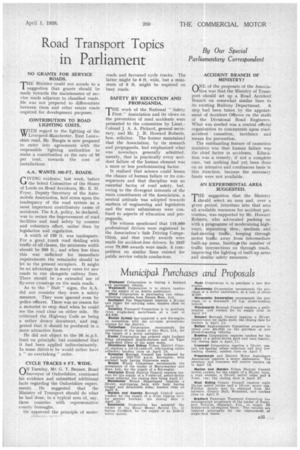Road Transport Topics
Page 49

If you've noticed an error in this article please click here to report it so we can fix it.
in Parliament
By Our Special Parliamentary Correspondent
NO GRANTS FOR SERVICE ROADS.
THE Minister could not accede to a suggestion that grants should be made towards the maintenance of service roads adjacent to classified roads. He was not prepared to differentiate between them and other estate roads required for development purposes.
CONTRIBUTION TO ROAD LIGHTING COSTS.
WITH regard to the lighting of the VIr Liverpool-Manchester, East Lancashire road, Mr. Burgin is now prepared to enter into agreements with the responsible lighting authorities to make a contribution at the rate of 50 per cent. towards the cost of installations.
A.A. WANTS 300-FT. ROADS.
GIVING evidence; last week, before the Select Committee of the House of Lords on Road Accidents, Mr. E. H. Fryer, Deputy Secretary of the Automobile Association, laid stress upon the inadequacy of the road system as a most important contributory cause of accidents. The A.A. policy, he declared, was to secure the improvement of road_ facilities and road safety by consent and voluntary effort, rather than by legislation and regulation.
A width of 120 ft. was inadequate. For a great trunk road dealing with traffic of all classes, the minimum width should be 300 ft., and when less than this was sufficient for immediate requirements the remainder should be let to the present occupiers. It might be an advantage in many cases for new roads to run alongside railway lines. There should be an extended use of fly-over crossings on the main roads.
As to the " Halt" signs, the A.A. did not consider they were a safety measure. They were ignored even by police officers. There was no reason for a motorist to stop dead when he could see the road clear on either side. He criticized the Highway Code as being a rather dreary document, and suggested that it should be produced in a more attractive form.
He did not object to the 30 m.p.h. limit on principle, but considered that it had been applied indiscriminately. In some districts he would rather have a "no overtaking" order.
CYCLE TRACKS 9 FT. WIDE.
rIN Tuesday, Mr. G. T. Bennet, Road N.../Surveyor of Oxfordshire, continued his evidence and submitted additional facts regarding the Oxfordshire experiments. He suggested that the Ministry of Transport should do what he had done, in a typical area of, say, three counties with representative county boroughs.
He approved the principle of motor roads and favoured cycle tracks. The latter might be 6 ft. wide, but a minimum of 9 ft. might be required on busy roads.
SAFETY BY EDUCATION AND PROPAGANDA.
THE work of the National "Safety First" Association and its views on the prevention of road accidents were presented to the committee by Lieut.Colonel J. A. A. Pickard, general secretary, and Mr. J. R. Howard Roberts, hon. solicitor. The former maintained that the Association, by its research and propaganda, had emphasized what was nowadays generally admitted, namely, that in practically every accident failure of the human element was a more or less predominating factor.
It realized that science could lessen the chance of human failure or its consequences and that discipline was an essential factor of road safety, but. owing to the divergent interests of the main constituents of the Association, a neutral attitude was adopted towards matters of engineering and legislation and the main submissions were confined to aspects of education and propaganda.
The witness mentioned that 110,000 professional driers were registered in the Association's Safe Driving Competition, and that yearly awards were made for accident-free drivers. In 1937 over 79,000 awards were made. A competition on similar lines existed for public service vehicle conductors. ACCIDENT BRANCH OF MINISTRY?
rANE of the proposals of the Associa
tion was that the Ministry of Transport should set up a Road Accident Branch on somewhat similar lines to its existing Railway Department. A step had been taken by the appointment of Accident Officers on the staffs of the Divisional Road Engineers. What was needed was a central official organization to concentrate upon roadaccident causation, incidence and means for prevention.
The outstanding feature of causation statistics was that human failure was the chief factor in accidents, Education was a remedy, if not a complete cure, but nothing had yet been done on an intensive and continuous basis in this direction, because the necessary funds were not available.
AN EXPERIMENTAL AREA SUGGESTED.
THE suggestion that the Ministry should select an area and, over a given period, introduce into that area all available resources for accident prevention, was supported by Mr. Howard Roberts, who advocated pushing on with a programme of modernizing highways, separating slow, medium and fast-moving traffic, keeping through motor traffic away from intermediate built-up areas, limiting‘the number of traffic intersections on through roads, improving the lighting of built-up areas and similar safety measures.




























































































